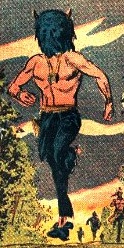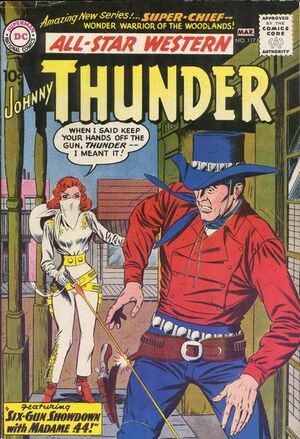 I've written about the Indian superhero called Super-Chief before. He first appeared in ALL-STAR WESTERN #117 (March 1961). Now thanks to correspondent Kevin Breen, I've finally read the comic.
I've written about the Indian superhero called Super-Chief before. He first appeared in ALL-STAR WESTERN #117 (March 1961). Now thanks to correspondent Kevin Breen, I've finally read the comic.The contents
"Six-Gun Showdown with Madame .44!" Western hero Johnny Thunder tussles with Madame .44, a female counterpart. She seems to be a robber, but she steals only limited amounts of money. She gets the best of Thunder, but then partners with him to save some children from a band of Arapaho "hotheads" on horseback. After scaring them off, she reveals that she takes only what rich landowners have swindled from people like her father.
How bad is it? The Indians are generic half-naked Plains "braves" who wield bows and rifles. They're your typical anonymous savage warriors who kill and maraud for no reason. The text describes them as "redskin renegades," which I guess is meant to soften the stereotyping. (Everyone except the renegades lives peacefully on the reservation, presumably.)
"Iroquois: The People of the Long House." A two-page featurette tells how the five tribes of the Iroquois battled each other until Hiawatha united them. It goes on to say they promoted peace only among themselves while conquering most of the mid-Atlantic region. Images of Indians fighting, uttering war cries, and attacking a fort reinforce the idea that Indians were violent and savage.
How bad is it? Foolishly, these Indians also look like generic half-naked Plains "braves." Even worse, they're shown battling among themselves on horseback. The Iroquois didn't have horses when they formed the Haudenosaunee League; they united before the Spaniards arrived and introduced horses to the hemisphere. In fact, I don't think the Iroquois ever used horses, since they didn't have contact with the Spaniards in the West.
"The Crowning of Super-Chief." The old chief of a generic band of Iroquois has died. Flying Stag, head of the Wolf Clan, is the obvious choice to replace him. But three other clan leaders are jealous and lure Flying Stag into a pit trap.
He calls upon the Great Spirit, aka Manitou, to help him. A meteor crashes into the pit and a voice answers his prayer. It tells him he's been granted "mighty powers" to help his people as Super-Chief.
Wearing a buffalo head, Super-Chief bests his rivals and is named head man. The embittered opponents try to destroy him by starting an avalanche, lighting a fire, and coaxing another tribe to attack. Super-Chief saves his tribe by deflecting all these perils.
How bad is it? At least these generic Indians have mohawks, which makes them look roughly Iroquois. The text uses a few words and concepts appropriate to the Iroquois. Flying Stag wants peace while the other clan leaders want war. He correctly notes that each clan uses paraphernalia unique to it.
On the other hand, these Iroquois live in teepees. Duh. Apparently the author of this story didn't read the accompanying featurette describing the Iroquois as "The People of the Long House." And the main supporting characters have the most stereotypical names imaginable. The old medicine man is Grey Eagle and the innocent maiden is White Fawn.
All in all, you can see how things were starting to change in 1961. Along with the usual generic Indian savages, ALL-STAR WESTERN #117 gave us a few bits of (reasonably) authentic Iroquois lore and a chief who wants peace for his people. Similarly, it described ranchers as less than the stalwart "masters of all they survey" seen in Western movies. These are among the first hints of revisionism in our American (comic book) mythology.


No comments:
Post a Comment
Note: Only a member of this blog may post a comment.